#valproic acid
Explore tagged Tumblr posts
Text
I just wanna stop feeling numb goddamn it wdym valproic acid or whatever I wanna feel again
#valproic acid#psych meds#jirai kei#jiraiblr#actually mentally ill#jirai girl#jiraiblogging#i wanna feel#lifestyle jirai#jirai onna#landmineblr#landmine kei#landmine type#landmine girl
10 notes
·
View notes
Text

OLVIDÉ PUBLICAR ESTO. POR FAVOR, COMPARTIR.
Si conoces alguien que esté en Venezuela, envíaselo. Así no sufra de convulsiones o necesite el medicamento, que lo sigan enviando.
Translation:
I FORGOT TO PUBLISH THIS. PLEASE SHARE.
If you know someone who is in Venezuela, send them this, even if they don't suffer from convulsions o need this medicine (valproic acid), they still can keep sharing.
They have shipping for all of Venezuela!
5 notes
·
View notes
Text
Valproic Acid - Pharmaceutical Reference and Impurity Standards | Simson Pharma
Valproic acid is commonly prescribed as a mood stabilizer for individuals with bipolar disorder. It helps to prevent or reduce the intensity of manic episodes and may also have some antidepressant effects.

Valproic acid is a pharmaceutical compound that is used for the treatment of various medical conditions. It belongs to a class of drugs known as anticonvulsants or mood stabilizers.
Valproic acid works by increasing the levels of a neurotransmitter called gamma-aminobutyric acid (GABA) in the brain, which helps to calm excessive electrical activity and stabilize mood.
Know more :- https://www.simsonpharma.com/promotions/valproic-acid-impurity-standards
#Valproic Acid#Pharmaceutical Reference Standards#Impurity Standards#Simson Pharma#Pharmaceutical Compound#Anticonvulsants
2 notes
·
View notes
Text
https://livealthbiopharma.com/products/sodium-valproate-valproic-acid-controlled-release-tablets/
0 notes
Text
Serum concentrations of valproic acid in people with epilepsy: Clinical implication
Image: Max Pixel Article published in J. Pharm. Pharmacogn. Res., vol. 10, no. 6, pp. 1117-1125, November-December 2022. DOI: https://doi.org/10.56499/jppres22.1500_10.6.1117 Angel T. Alvarado1*, Juan Cotuá2, Maryori Delgado2, Alexis Morales3, Ana María Muñoz4, César Li Amenero5, María R. Bendezú6, Jorge A. García6, Doris Laos-Anchante6, Felipe Surco-Laos6, Berta Loja7, Mario Bolarte-Arteaga8,…

View On WordPress
0 notes
Text
Part 17: A Thankless Job
Next Part
Part 1
Previous part
Masterpost
CW: quite a lot of blood, gore.

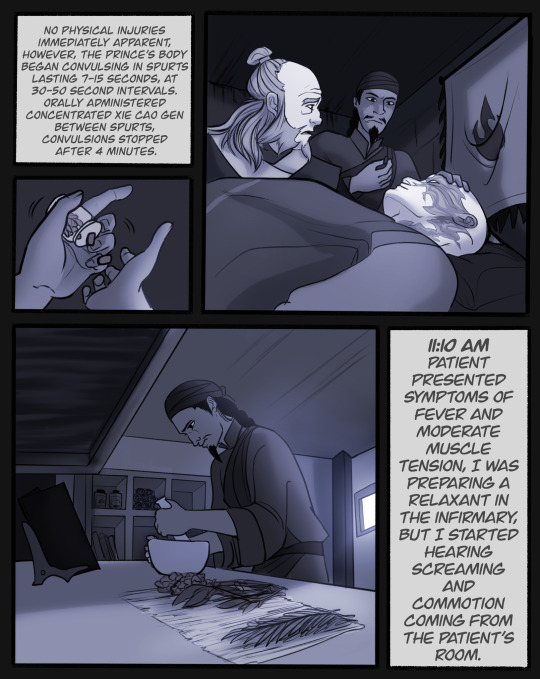

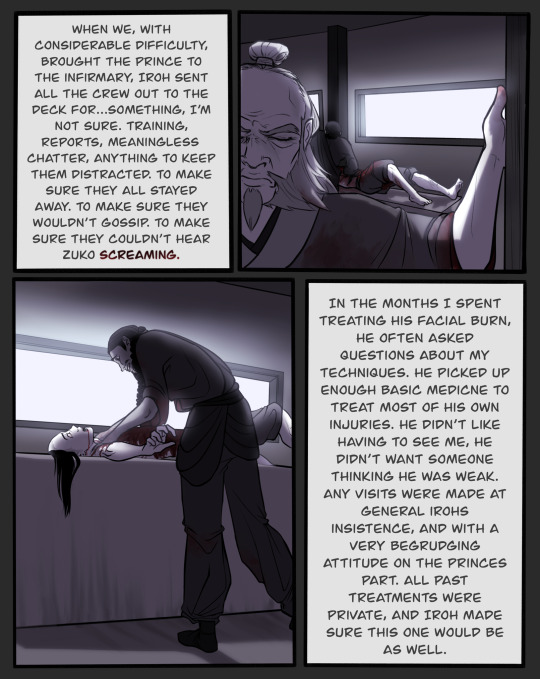
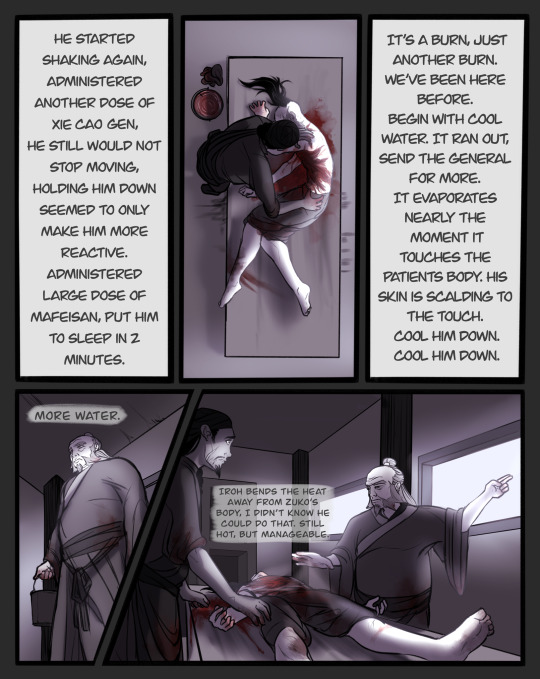
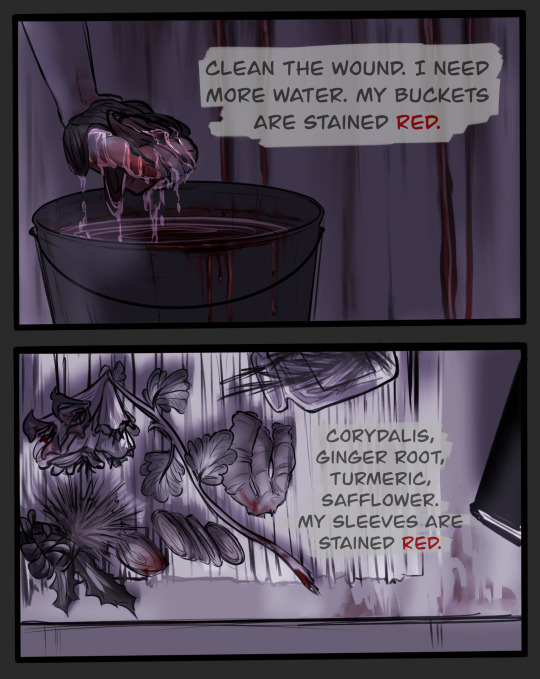

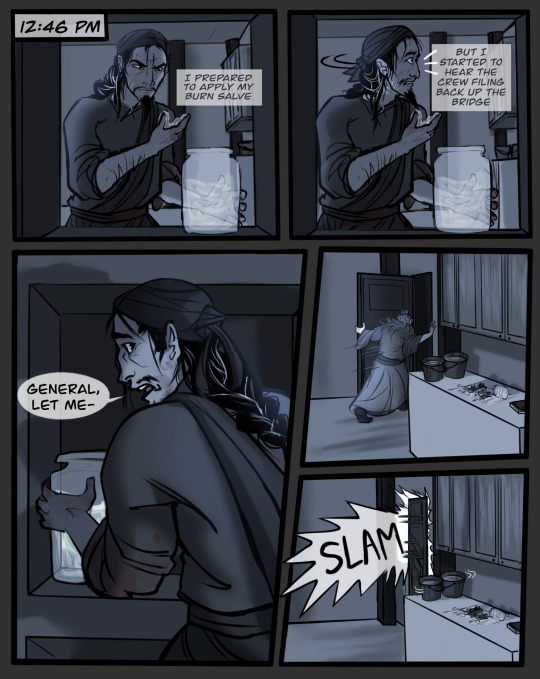

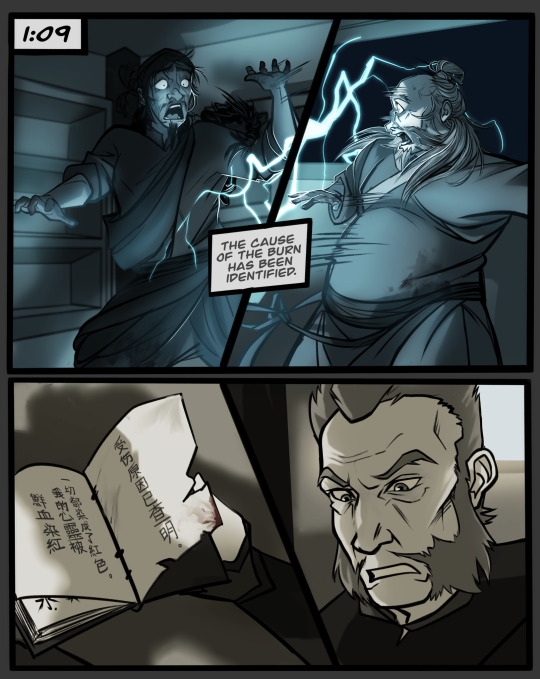
notes:
缬草根 xie2cao3gen1 - valerian root, of the valerian flower, which contains valproic acid- C8H16O2 - Anticonvulsant; It can treat seizures and bipolar disorder.
麻沸散 ma2fei4san4- a herbal oral anesthetic used in ancient china, it’s exact ingredients are unknown, but many believed it contained powdered cannabis or monkshood.
Corydalis flower/root, Turmeric, Ginger Root, and Safflower all contain pain-relieving compounds.
YiSheng’s burn salve is a mixture of aloe vera, honey, and tea tree oils.
This is the longest part yet!
Yishengs logbook:
早上-六點三十二
病人:祖寇王子
這早甲板上祖寇王子突然的昏倒。甲板水手然洱 來接我。艾洛將軍幫我把王子抬到他的住處。
受伤原因已查明.
一切都染成了紅色。我的心靈被鮮血染紅
#if this is a dream au#atla#avatar the last airbender#original comic#fan comic#prince zuko#uncle iroh#oc YiSheng#lieutenant jee#cw blood#cw: gore#if this is a dream don’t wake me#support artists#what does yishengs journal say?
487 notes
·
View notes
Text
when i was last on a ppi (ranitidine, though i was also on omep for years) i used to have just the worst stomach cramping and shit. ended up in the er because someone thought my appendix busted open or gallstones or something. i at the time attributed it to my chronic nsaid use but i am on a real stomach eroder rn and was fine UNTIL i took the omeprazole. also having some signs of poor bile salt absorption which is implicated in pancreal and gallbladder/liver stuff, so i might ask for an examination to rule out any of those freaking it (normally an ultrasound is sufficient to at least examine the organs)
soooo apparently omeprazole is associated with pancreatitis and lo, most of my pain has been upper left quadrant. stopping that med until i can talk with my doctor ^_^
#postingviolence#i mostly think pancreas instead of gallbladder bc i am disposed to pancreatitis from being on corticosteroids for so long#+ some of the meds they gave me for my headache initially are directly toxic to the organ. namely valproic acid#and they gave me a Turbo Dose of that shit
1 note
·
View note
Text
We're trying to help others in need, spread information, and boost fundraisers!
Please consider checking this drive out, it has information about Venezuela, charity, artists that need commissions and so much more!
————
This docs made by @beforeliteracytherewasdeez
————
Also, please do check the following fundraisers!: Feel free to add / send us more fundraisers to add!
IMPORTANT: Every single fundraiser in this blog is tagged either #fundraisers or #fundraiser . This post gets rebloggued everytime it changes, please consider sharing and reblogging, too! We appreciate the likes, but the reblogs it's what will give the post more visibility and help the fundraisers get more attention!!! Also, if you find a fundraiser we haven't rebloggued, please tag us!!
MASTERPOST OF FUNDRAISERS
For these countries: 🇵🇸🇻🇪🇨🇺🇾🇪🇳🇮🇨🇩🇸🇩🇭🇹🇪🇹🇱🇧. Subjected to changes (ex. If we find/rb more fundraisers, we'll add them).
I haven't organized this one, but it has a various links. Shared by @serica-e
Palestine 🇵🇸
Masterpost of fundraisers for 🇱🇧🇵🇸
Info in how to donate + fundraisers (Spanish)
URGENT: help @yousra1-gaza Yusra' ask
Multiple links
Ways to help Palestinians
Help Samira!
The original ask was delated but this one has useful links.
Osama Basil
A list of asks
eSims
Needa's campaign
Juliet's ask | post
Imithital's ask
Hamdi Ayyad's ask
Hazem Mohammed
Salam's ask | Post
Docs of people vetted by @gazagfmboost
Docs of people vetted by @nabulsi and @el-shab-hussein
Donations for @90-ghost
Salah's family.
Sonic says freedom!
Juliet's ask
@pkmnbutch-inactive 's list of Palestinians' campaigns
Basel Ayyad's ask
Mahmoud's ask
Mohammed Ayyad's ask to @epickiya722
Hossam Al-Ser'a ask to @bobadila
Mahed's ask
Ali's ask
Asks/tags shared by @pteropods
Baraa Al-Shorafa's ask
Nadine's ask
Hadeel's ask
Nada's ask
@yasermohammad 's ask and donations
Ibrahim Mahed's ask
List of fundraisers by @tododeku-or-bust
Help Noor | ask
Khaled's Family's Ask
Help the family of a Children's Books Illustrator flee!
List of fundraisers shared by: @illamda-spaminations
Venezuela 🇻🇪
This raffle ends on September 10th, 2024!! By @silvervarian
Ways to help venezuelans
More ways to help venezuelans
Help @Lunes 's grandma, Dorka!
@pumpariah 's Commissions to Help Parents Flee!
The original ask was delated but this one has useful links.
Multiple links
Victor & Eldy
Valproic acid, national shipping
Vikoon's commissions shared by @systhemes
More venezuelan commissions
@transform-artion 's Commissions
Help a Venezuelan Family Flee! Shared by @yuissamidare
Cuba 🇨🇺
URGENT: Ester Asprón, a 2 years old.
Pocket's commissions!
Yemen🇾🇪
Multiple links
Nicaragua 🇳🇮
The only Nicaragua's links I've found in this hellsite
Democratic Republic of Congo 🇨🇩, Sudan 🇸🇩, Haiti 🇭🇹, Ethiopia 🇪🇹 , Lebanon 🇱🇧
Note: Campaigns for these countries oftentimes are together. We may, in a future, give a section for any and all of these countries, but for now they are together.
Fundraisers shared by @serica-e
Eman Abdelrahman's campaign
List of fundraisers shared by @marigoldcanaries
Help the Haitian Refugees in Ohio shared by @maeamian | A new Support Center @resolutedoubt
Masterpost of fundraisers for 🇱🇧🇵🇸
Help marginalized Lebanese People (ways to help: ) shared by @schoolhater
#fundraisers#free venezuela#free palestine#free congo#free cuba#free Nicaragua#free yemen#free democratic Republic of Congo#free sudan#lebanon#haiti#ethiopia
79 notes
·
View notes
Text
on that note, valerian root* and its derivatives (valeric acid, valproate/valproic acid/depakote) are indirectly serotonergic [increase tryptophan, which is converted to serotonin] and can interact with other medications to cause serotonin syndrome
*valerian root, the popular herbal sleep aid, carries significantly less risk than the more concentrated pharmaceuticals derived from it, but it's still worth checking it against other medications extensively before using it
9 notes
·
View notes
Text
instagram
Okay, I have to say something.
One of the main problems of current medicine is not the amount of antivaxxers, but the division of society on pro-vaccines and anti-vaccines. And people like this scientist on the video are only expanding the abyss further and futher - in long run, causing more and more people losing faith in vaccinations and in medicine in general. Why, you ask me?
Because the problem of post-vaccinations' complications didn't disappear anywhere - moreover, it only became bigger.
For the last two decades, people went absolutely nuts, vaccinating everything regardless of time periods between shots, the age, the sex, the overall ability of a pathogen to mutate, etc. It was our absolute failure as of the worldwide medical community - and the best proof is the Covid vaccine and its effect.
But enough about Covid. Let's take another example - the MMR vaccine: live-attenuated, three doses, mostly applied to children at 12-15 months. My friend had one at 12 moths, too - however, back then, ~20 years ago, her parents noticed strange movements of her, after the first doze. She arched her back and did not respond to external stimuli. Her parents didn't attach much importance to it. After the second doze (she was already 4 year-old), she developed severe seizures. She was diagnosed with convulsive syndrome, and she had to take Convulsofin (Valproic acid) for 3 years. If you didn't know, Valproic acid is extremely hepatotoxic and can cause acute pancreatitis, thrombocytopenia, hyperammonemia, coma and death. It was also pretty expensive back then. My friend was prescribed of such medication because anything weaker just didn't improve her condition at all - and her neurologist assumed it would be easier for a child than for an adult to adapt and overcome such a dangerous drug. Luckily, she had survived, but she remained disabled for the rest of her life, even though her parents paid crazy amount of money on rehabilitation. Even nowadays, when we occasionally meet, she sometimes flinches and then complains of a headache. Obviously, her quality of life is pretty impaired and has lots of restrictions.
20 years ago, despite there were MANY of such cases, there were no public researches, publications, algorithms "what to do if" - in Ukraine, I mean. It looked as if there was an order from above to keep silent about everything that was happening. Nowadays, the World Health Organisation writes "febriles may occur but they are typically short-term and do not lead to long-term neurological issues" - I want to show them my friend and ask whether they can pay off her medications and rehabilitation costs for all these years. Because there are no long-term issues! There is no war in Ba Sing Se. Maybe it was just her parents' whim - to waste so much money!
The problem of modern medical system is that no one cares what will happen to you, to your child, after vaccination.
You are not listened to, you are labelled immediately as "antivaxxer" - and if you decide to vaccinate, and it gives you severe complications, and you manage to NOT die because of them, all the doctors around are like:

"Welp, it's your problem now. Who cares if you have to pay for rehabilitation from your own pocket - at least you are an acceptable member of society now!"
Is it really that surprising that between "possibly getting ill" and "assurely getting ill after vaccination", a parent usually chooses the first option for their child? Especially if they know that the risk for complications runs in the family? They do not vaccinate you with some random bacteria but with weak versions of the pathogen - the live-attenuated vaccines are the most heavy to deal with. The overload of immunity does exist and can happen after vaccination - and denying the problem because it is being spoken by the person you don't like is a very immature, very unprofessional behaviour, especially from a doctor/scientist.
There is no compensation for developing complications, there is no genetic screening for a vaccine's safety, there is no emergency help algorithm, there are no rehabilitation programs, hell, there is no education about post-vaccine complications treatment and prevention even. There are no safety guarantees. There is probably no improving of vaccines either.
And then they wonder why people vote for drug-addicted fashists like Trump and Elon Musk.
People are not lab mices. People should have a choice whether to apply medication or not. Just because complications are rare doesn't mean they must be ignored. People should not be ostracised for not wanting to vaccinate. There are people like my friend for whom ANY vaccination is strictly contraindicated for the high risk of complications' reccurance - to vaccinate them is the same as to execute them - but no one listens to them, although its our job as doctors, as scientists - not be indifferent. Indifferent doctors are called flayers, slaughterers, human experimentation perpetrators, sometimes even war criminals.
The guy on the video is indifferent. So is Elon Musk, however, he just simply broadcasts the thoughts and feelings of millions of people around the world, whose loved ones had to suffer from such medical indifference and ostracism. Because those farmaceutical oligarchs are interested in incitement of conflict and hatred between the two sides, in selling as much stuff as possible - regardless whether it's useful and safe - those guys are no different from Elon Musk at all, except for being more two-faced.
In conclusion:
We must not spread hatred. If a person doesn't want to vaccinate, listen to their arguments - maybe they have a good reason for that. Don't be blind, be kind.
We must develop safety guarantees and/or compensation for people who get complications after vaccination. Low risk doesn't mean your loved one won't be a victim of it.
We must educate people about what to do if you develop severe reaction on a vaccination. Ignorance breeds mistrust and ruins the belief in doctors. If the parents of my friend were educated, they wouldn't have ignored the first signs, they wouldn't have done the second shot - and my friend wouldn't have become a disabled for life.
We must not force people to vaccinate unless it's a 100% death-rate disease. We are not Auschwitz.
We must not spend so much time on Internet. We must not divide the society for likes, kudos, reblogs, views, whatever.
2 notes
·
View notes
Photo

Cause and Effect
It’s possible to know what's causing a problem without understanding how it's doing harm. Researchers knew that mutations in the gene which makes the protein INVS is linked to nephronophthisis – a cause of kidney failure in young people. But without understanding the mechanism, this knowledge hasn’t led to new treatments. A new study examined the effect of removing INVS from various kidney cells, and found that cysts and scarring – symptoms of nephronophthisis – then arose in kidney lining cells but not others. These impacts were reduced when cilia – tiny protrusions from cells – were removed, suggesting they are key to the disease progression. They observed some affected cells over-proliferating (green in the kidney section pictured, with lining cells encircled in pink), which is a driver of cysts. Armed with this understanding, the researchers discovered a new potential treatment, valproic acid, which is already in use for other conditions like epilepsy.
Written by Anthony Lewis
Image from work by Yuanyuan Li and Wenyan Xu, and colleagues
Department of Genetics, Yale University School of Medicine, New Haven, CT, USA
Image originally published with a Creative Commons Attribution 4.0 International (CC BY 4.0)
Published in eLife, March 2023
You can also follow BPoD on Instagram, Twitter and Facebook
6 notes
·
View notes
Text
The value of monitoring lamotrigine concentrations remains unestablished to date. Due to the pharmacokinetics between lamotrigine and other drugs and their effect on lamotrigine concentration, clinical judgment must be exercised during concomitant use if there are concerns regarding lamotrigine levels. Dofetilide can have a severe interaction with lamotrigine, and the combination is strongly discouraged. Other drugs with potential serious interactions include valproic acid, rifampin, estrogen-containing contraceptives, and estrogen replacement therapy medications, as well as certain barbiturates.
Labs should include pertinent serum levels of concurrent anticonvulsants, liver function testing, and renal function assessments. Clinical team staff should spend ample time educating patients on monitoring themselves for hypersensitivity, particularly rashes or other skin changes occurring near or on the mucosa. Patient education should also include discussing how to monitor for changes in seizures and their frequency and duration. Patients should also monitor for changes in suicidality, including suicidal thoughts and increased desire to commit suicide. Finally, patients should receive counsel on how to watch for signs/symptoms of aseptic meningitis.
2 notes
·
View notes
Text
Depakote, oral and infusion, for migraines in children
A recently published study suggests that valproic acid (Depakene) given intravenously in an emergency room can relieve migraine headaches in children. The researchers also showed that giving these children an oral version of this drug, divalproex sodium (Depakote), does not reduce the frequency of future migraine attacks. Divalproex sodium was first approved by the FDA in 1983 for the treatment…
View On WordPress
2 notes
·
View notes
Text
Can Jaundice Result from Drug-Induced Liver Damage?

When addressing liver-related health concerns, including jaundice management for liver diseases, understanding the root causes is vital. One often-overlooked cause is drug-induced liver damage. As a jaundice treatment specialist at GEM Hospital, I’ve encountered many cases where medications significantly impact liver health. If you're seeking effective jaundice treatment in Chennai, our hospital provides comprehensive care options tailored to your needs. Learn more about jaundice treatment here.
What is Drug-Induced Liver Damage?
Drug-induced liver damage, also known as drug-induced hepatotoxicity, occurs when certain medications or toxins harm the liver. The liver plays a critical role in processing and detoxifying substances, but excessive exposure to harmful drugs can lead to inflammation, scarring, or severe liver damage, ultimately causing jaundice.
How Does Drug-Induced Liver Damage Cause Jaundice?
Jaundice results from the buildup of bilirubin, a yellow pigment produced during red blood cell breakdown. Drug-induced liver damage can impair the liver’s ability to process and excrete bilirubin, leading to its accumulation in the bloodstream and causing yellowing of the skin and eyes.
Common Drugs That Can Trigger Liver Damage
Some commonly used medications are more likely to cause liver toxicity, increasing the risk of jaundice. These include:
Acetaminophen (paracetamol) when taken in high doses.
Antibiotics like amoxicillin-clavulanate or isoniazid.
Statins for cholesterol management.
Anti-seizure medications such as valproic acid.
Herbal supplements and traditional medicines with unknown ingredients.
It’s essential to consult a healthcare professional before starting or continuing any medication.
Signs and Symptoms of Drug-Induced Jaundice
Be vigilant about symptoms that may indicate liver damage. These include:
Yellowing of the skin and eyes (jaundice).
Dark-colored urine.
Pale stools.
Fatigue and weakness.
Abdominal pain, especially in the upper right side.
Nausea and vomiting.
If you experience any of these symptoms while taking medications, seek medical attention promptly.
Risk Factors for Developing Drug-Induced Liver Damage
Certain individuals may be more susceptible to drug-induced liver damage. Risk factors include:
Pre-existing liver conditions.
Excessive alcohol consumption.
Advanced age.
Genetic predisposition to liver issues.
Concurrent use of multiple medications.
Diagnosis of Drug-Induced Jaundice
Diagnosing jaundice caused by drug-induced liver damage involves several steps:
Detailed Medical History: Reviewing medication use, dosage, and duration.
Physical Examination: Assessing symptoms and signs of jaundice.
Liver Function Tests (LFTs): Measuring enzyme levels to evaluate liver health.
Imaging Studies: Ultrasound or MRI to check for structural abnormalities.
Liver Biopsy: In some cases, to confirm the extent of liver damage.
Treatment Options for Drug-Induced Jaundice
Treating drug-induced jaundice involves addressing the underlying liver damage. Key steps include:
1. Stopping the Offending Drug
Discontinuing the harmful medication is the first step. Alternative treatments may be suggested to manage the primary condition.
2. Supportive Care
Hydration: To flush out toxins.
Nutritional Support: Ensuring proper liver function recovery.
3. Medications
Antioxidants or medications to reduce liver inflammation.
4. Monitoring and Follow-Up
Regular check-ups and liver function tests are crucial to track recovery progress.
Tips to Prevent Drug-Induced Liver Damage (Point-by-Point Structure)
Follow Prescriptions Strictly: Never exceed the recommended dosage.
Avoid Self-Medication: Always consult a doctor before taking new drugs.
Monitor Liver Function: If you’re on long-term medication, get regular liver function tests.
Limit Alcohol Intake: Alcohol can amplify liver damage risks.
Inform Doctors About Existing Conditions: Pre-existing conditions like hepatitis should be communicated to your physician.
Why Choose GEM Hospital for Jaundice Treatment?
At GEM Hospital, we specialize in managing liver diseases and treating jaundice caused by various factors, including drug-induced liver damage. Our state-of-the-art facilities and experienced team ensure personalized care to help restore liver health.
Schedule a Consultation with Dr. R. Vinoth Kumar
If you’re dealing with jaundice or suspect drug-induced liver damage, don’t delay seeking expert advice. As a specialist at GEM Hospital, I’m here to help. Schedule an appointment today and take the first step towards effective jaundice management and improved liver health.
0 notes
Text
Biotinylated Monoclonal Valproic Acid Antibody
Biotinylated Monoclonal Valproic Acid Antibody Catalog number: B2019293 Lot number: Batch Dependent Expiration Date: Batch dependent Amount: 100 ug Molecular Weight or Concentration: NA Supplied as: Solution Applications: a molecular tool for various biochemical applications Storage: -20°C Keywords: Biotin Monoclonal Valproic Acid Antibody Grade: Biotechnology grade. All products are highly pure.…
0 notes
Text
Antiepileptic Drugs
Anatomy, Physiology, and Pathophysiology Overview
Epilepsy is a disorder of the brain manifested as a chronic, recurrent pattern of seizures. It is the most common chronic neurologic illness, affecting 3 million people in the United States and 50 million people worldwide.
A seizure is a brief episode of abnormal electrical activity in the nerve cells of the brain.
A convulsion is a more severe seizure characterized by involuntary spasmodic contractions of any or all voluntary muscles throughout the body, including skeletal, facial, and ocular muscles. Commonly reported symptoms include abnormal motor function, loss of consciousness, altered sensory awareness, and psychic changes.
Seizures are classified as follows: partial-onset seizures or those originating in a more localized region of the brain; status epilepticus, characterized by generalized tonic-clonic convulsions that occur repeatedly in succession; and tonic-clonic seizures involving initial muscular contraction throughout the body (tonic) and progressing to alternating contraction and relaxation (clonic phase).
Generalized onset seizures, formerly called grand mal seizures, are characterized by neuronal activity that originates simultaneously in the gray matter of both hemispheres.
Tonic-clonic seizures begin with muscular contraction throughout the body (tonic phase) and progress to alternating contraction and relaxation (clonic phase).
Partial onset seizures originate in a localized or focal region (e.g., one lobe) of the brain.
In status epilepticus, multiple seizures occur with no recovery between them. If appropriate therapy is not prompt, hypotension, hypoxia, brain damage, and death can quickly ensue.
Excessive electrical discharges can often be detected by an electroencephalogram.
Fluctuations in the brain’s electrical potential are seen in the form of waves. These waves correlate well with different neurologic conditions and are used as diagnostic indicators.
Epilepsy without an identifiable cause is known as primary epilepsy or idiopathic epilepsy. Primary epilepsy accounts for roughly 50% of cases.
In other cases, epilepsy has a distinct cause, such as trauma, infection, cerebrovascular disorder, or other illness; this is known as secondary or symptomatic epilepsy.
The chief causes of secondary epilepsy in children and infants are developmental defects, metabolic disease, and injury at birth.
Febrile seizures occur in children 6 months to 5 years of age and are caused by fever. Children usually outgrow the tendency to have such seizures, and thus these seizures do not constitute a chronic illness.
In adults, acquired brain disorder is the major cause of secondary epilepsy; including head injury, disease or infection of the brain and spinal cord, stroke, metabolic disorders, and drug reactions.
https://bb-csuohio.blackboard.com/bbcswebdav/pid-7116313-dt-content-rid-80385574_1/xid-80385574_1
Pharmacology Overview
Antiepileptic drugs, also called antiepileptic drugs, are a more appropriate term because many of these medications are indicated for the management of all types of epilepsy, and not necessarily just convulsions.
Anticonvulsants, on the other hand, are medications that are used to prevent the convulsive seizures typically associated with epilepsy.
The goal of antiepileptic drug therapy is to control or prevent seizures while maintaining a reasonable quality of life. Approximately 70% of patients can expect to become seizure-free while taking only one drug.
Single-drug therapy must fail before multidrug therapy is attempted. The dosage of the medication is slowly increased until the seizures are controlled or until clinical toxicity occurs.
Therapeutic drug monitoring of serum drug concentrations provides a useful guideline in assessing the effectiveness of and adherence to therapy.
The antiepileptic drugs traditionally used to manage seizure disorders include barbiturates, hydantoins, and iminostilbenes, plus valproic acid.
Second- and third-generation antiepileptics are also available.
Newer approved drugs include perampanel (Fycompa,) ezogabine (Potiga), vigabatrin (Sabril), eslicarbazepine (Aptiom), clobazam (Onfi), and brivaracetam (Briviact). These drugs fall into the miscellaneous category of antiepileptics and have greatly expanded the options currently available to treat patients with seizure disorders.
Ezogabine (Potiga) is indicated for adjunctive therapy for partial-onset seizures and can cause potential vision loss and skin discoloration both of which may be permanent. The FDA recommends it be used only in patients who have not responded to other drugs.
Perampanel (Fycompa) is also indicated as adjunctive therapy for partial-onset seizures. It is associated with a high incidence of dizziness.
Vigabatrin (Sabril) is indicated for refractory complex partial seizures. It carries the risk of visual impairment and as such is only available through a restricted distribution program.
Eslicarbazepine (Aptiom) is indicated as adjunctive therapy for partial-onset seizures.
Clobazam (Onfi) is a benzodiazepine indicated as adjunctive therapy for Lennox-Gastault syndrome.
Brivaracetam (Briviact) is indicated for partial-onset seizures in patients 16 years and older.
The major pharmacologic effects of antiepileptics are threefold. First, they increase the threshold of activity in the area of the brain called the motor cortex. Second, they act to limit the spread of a seizure discharge from its origin by suppressing the transmission of impulses from one nerve to the next. Third, they can decrease the speed of nerve impulse conduction within a given neuron.
Antiepileptics are used for the long-term maintenance treatment of epilepsy. However, they are also useful for the acute treatment of status epilepticus.
The only usual contraindication to antiepileptics is known drug allergy. Pregnancy is also a common contraindication; however, the prescriber must consider the risks to the mother and infant of untreated maternal epilepsy and the increased risk of seizure activity. Many women take antiepileptics throughout their pregnancy. The newer-generation antiepileptic drugs appear to be safer in pregnancy than the traditional drugs.
Antiepileptic drugs have many adverse effects, which often limit their usefulness. Many patients cannot tolerate the adverse effects, and therapy must be withdrawn.
Birth defects in infants of epileptic mothers are higher than normal, regardless of whether the mother was receiving drug therapy.
In December 2008, the U.S. Food and Drug Administration (FDA) required black box warnings on all antiepileptic drugs regarding the risk of suicidal thoughts and behavior. Patients being treated with antiepileptic drugs for any indication need to be monitored for the emergence or worsening of depression, suicidal thoughts or behavior, or any unusual changes in mood or behavior.
For certain antiepileptic drugs, the safe and toxic levels are very close together; that is, they have a narrow therapeutic range.
https://bb-csuohio.blackboard.com/bbcswebdav/pid-7116313-dt-content-rid-80385573_1/xid-80385573_1
Nursing Process
With the use of any of the antiepileptic drugs, perform a thorough physical assessment and obtain a comprehensive health and medication history so that any possible allergies, drug interactions, adverse reactions, cautions, and contraindications can be identified.
You must be able to distinguish between the different types of seizures and assess and document all symptoms, events, and problems that occur before, during, and after any seizure activity. This information may aid in the diagnosis of the type of seizure the patient is experiencing.
Thoroughly review the patient’s medical history and note any type of seizure disorder, precipitating events, and the duration, frequency, and intensity of the seizure activity.
Before giving these drugs, review the laboratory test results, which may include the results of red blood cell and white blood cell counts, clotting studies, and renal and/or liver function studies.
If barbiturates have been ordered, carefully assess not only the neurologic system but also vital signs because of the central nervous system depression associated with this class of drugs.
In addition, identify patients at high risk for excessive sedation for safety purposes.
Interventions for patients taking antiepileptic drugs are aimed at monitoring the patient while providing safety measures and securing the airway, breathing, and circulation.
Airway maintenance is of critical importance for epileptic patients because the tongue relaxes during seizure activity, falling backward and subsequently blocking the airway.
Maintain the patient’s airway in the same way as during cardiopulmonary resuscitation, using the chin lift or jaw thrust method.
Distinguish between the different types of seizures and assess and document all symptoms, events, and problems that occur before, during, and after any seizure activity.
With antiepileptic drug administration, adhere closely to the drug dose and frequency of dosing, as ordered. Close monitoring of dosing is important to attain therapeutic blood levels. Administering the antiepileptic drug at the same time every day is also important to maintain blood levels.
Grapefruit or related citrus fruits or pomegranate juice needs to be avoided with carbamazepine (Tegretol).
The occurrence of a therapeutic response to antiepileptic drugs does not mean that the patient has been cured of the seizures but only that seizure activity is decreased or absent.
Thoroughly document any response to the medication in the medical record.
Noncompliance with the drug regimen is the most important factor leading to treatment failure.
Monitor therapeutic blood levels at all times, and avoid abrupt withdrawal of the antiepileptic drug to prevent rebound seizure activity.
Intravenous infusions of antiepileptic drugs are very dangerous and must be managed cautiously, with adherence to hospital or facility policy and manufacturer’s guidelines. Avoid rapid infusions because of the risk of cardiac and/or respiratory arrest.
Older adult patients may experience paradoxical reactions to antiepileptic drugs, resulting in hyperactivity and irritability versus sedation.
0 notes